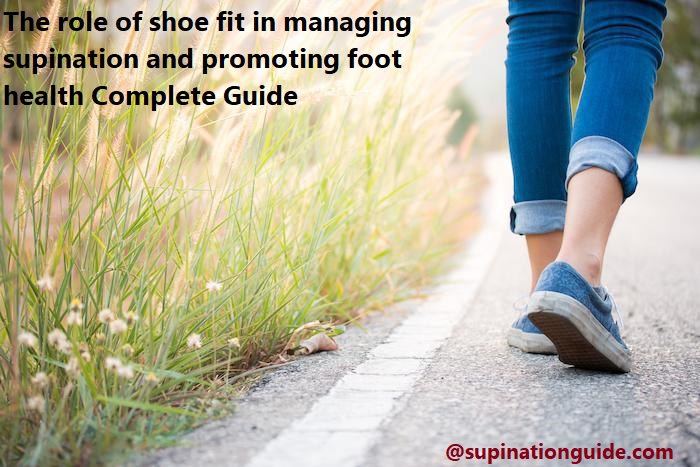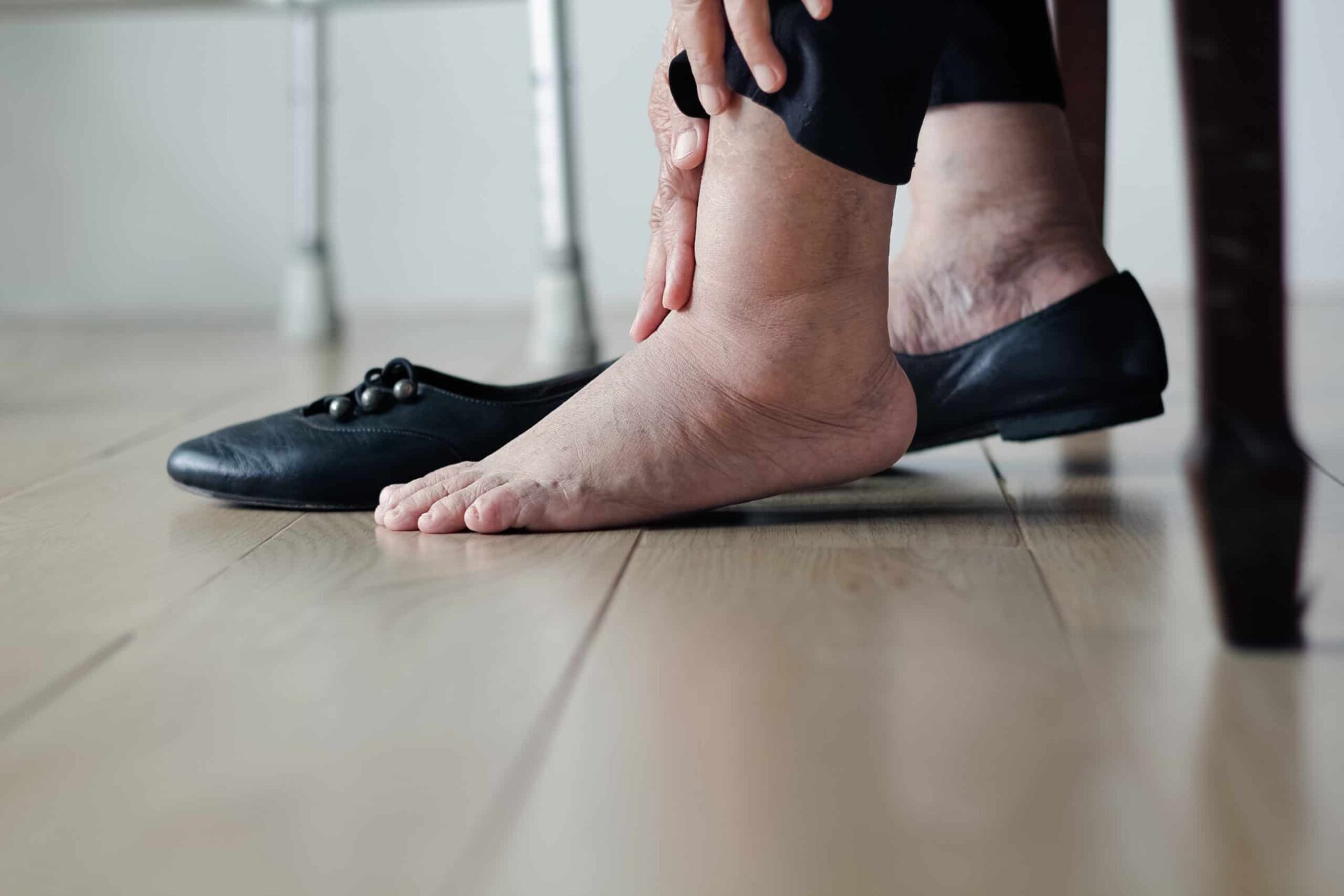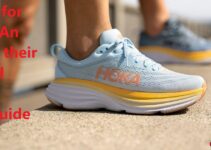Struggling with supination? You’re not alone!
Wearing the right shoe for your feet can greatly reduce the discomfort and pain caused by supination. In this guide, we explore how to find the perfect fit for your feet and how this can help you manage supination and promote healthier feet.
The health of a person’s feet is an important and often overlooked aspect of overall well-being. Well-cared-for feet not only look nice but also help people remain mobile and active. Those with foot ailments, such as supination or flat feet, can find it difficult to perform everyday tasks or partake in physical activities without pain or discomfort. Shoes can be a major factor in managing supination and promoting foot health, and finding the perfect pair that is properly fitted to the individual’s feet requires careful consideration.
In this guide, we will cover the basics of shoe fit, discuss strategies for managing supination, as well as explore supportive products that can aid in restoring foot health and reduce pain. We will provide insight into what factors should be considered when choosing shoes for those individuals with pronated or flat feet, helping them reach their full potential without limitation due to foot ailments.
Make sure to check with your orthopedic provider when purchasing new shoes — the correct fit is essential for cultivating healthy and strong feet!
Understanding Shoe Fit
It is difficult to overstate the importance of proper shoe fit for individuals who want to minimize their risk for developing foot conditions. As the American Podiatric Medical Association explains, “the elements of proper shoe fit are length, width, depth, heel counter stiffness and overall shoe stability.”
Length: Choose a shoe that is long enough to allow your toes plenty of room. Your longest toe should have at least a half-inch of space from the end of the shoe. If your feet are different sizes, buy shoes in the size of your larger foot.
Width: When trying on shoes make sure there is ample room between your feet and each side wall. Look for a curved last which hugs but doesn’t squeeze the shape of your foot and allows it enough flexibility while walking.
Depth: The height should be sufficient to permit free ankle movement while protecting the Achilles tendon and avoiding pressure points against it. Make sure there is no interference in this area when you flex your feet forward or downward during walking or running activities.
Heel Counter Stiffness: This part of the shoe must be rigid enough to support and protect your heel from too much movement which could cause blisters or bruises when you walk or run. It should offer good support without any slippage around your heel area from too much looseness in construction height.
Overall Shoe Stability: As you increase activity level, look for shoes with extra stability features through dual density midsoles, shanks (slender pieces tucked into diagonal pockets) and motion control devices like arch supports that can help keep feet level during strenuous use. Be aware that some manufacturers assume straight lasts instead angled ones when constructing shoes – leading to possible instability issues if this criteria isn’t satisfied as well as other changes potentially required as pointed out above when trying new sneakers on.

Explanation of the different components of a shoe and how they affect fit
Wearing the right footwear for a person’s foot type is important for optimal comfort and foot health. Understanding the anatomy of a shoe—including its components and how they affect fit—is an important part of finding the right shoe for you. This guide will explain each component of a shoe and how it can affect fit, plus tips for achieving the proper fit.
Uppers: The uppers, or the material that covers the top of the foot, is usually made from leather or synthetic fabrics. The upper part should provide enough room to accommodate your toes without squeezing, rubbing, or bulging. Some footwear styles are designed to provide more room in specific areas—such as ankle length boots—while others have a more snug construction.
Collars: The collar surrounds your ankle and can raise or lower depending on which style you choose to wear; this affects support around your ankle and can ease stress when padding isn’t present. Padded collars provide extra cushioning against potential rubbing and discomfort due to pressure points around your ankles.
Lining: All shoes should have some form of lining to help wick away moisture while also providing comfort while wearing them; leather uppers sometimes require extra lining protect from sweat and friction from prolonged use. Look for natural materials such as cotton, wool and suede; these are thought to be more breathable than synthetic linings.
Insole/Sock Liner: The insole (also known as a sock liner) provides cushioning against shock absorbency when walking on hard surfaces or running/jogging over rough terrain; in addition, it provides additional arch support when needed where specific shapes are provided by anatomical design (this will vary depending on foot condition). Insoles come in many sizes to match all shapes of feet including wide/narrow, low volumes & high volumes etc.; always buy insoles that match the size of your feet–anything smaller may compress too much under load causing discomfort & an ill-fitting pair should be changed immediately!
Midsole: The midsole acts like shock absorber providing cushioning underfoot during periods of intense activity or over rough terrain. It is designed to take up impact energy & also bounce back some energy into every step taken; modern designs include features such as air-cushioned chambers filled with foam beads which compress & rebound quickly thus adding bounce & life into every step taken whether walking running etc. By using different densities & thicknesses these layers can offer varying levels of protection depending on person’s needs & activity type undertaken!
Overview of different types of shoes and their fit characteristics
Having shoes that properly fit your feet is an important factor in maintaining comfort and promoting foot health over time. Depending on the shape and size of your foot, there are numerous types of shoes and shoe brands that are best suited for you. Here’s a guide to the different types of shoes and fit characteristics to help you find the right one for you.
Athletic Shoes – Athletic shoes come in various styles but all provide cushioning, stability, support, as well as protection from impact. Running/training shoes have more cushioning than tennis or basketball sneakers, while tennis shoes are designed specifically for lateral movement and maneuvering on hard courts. Each style should be fitted using a dynamic fitting process to account for the way they will move with the feet while running or playing sports.
Casual Shoes – Casual shoes come in both lace-up and slip-on styles. Athletic style casual shoes such as skateboard or moccasins provide comfort and shock absorption when worn with day-to-day activities such as shopping or running errands. Shoes with a rocker bottom sole provide added shock absorption and stability when walking on uneven surfaces; these forms of casual female footwear also look great!
Dress Shoes – Dress shoes come in various styles such as pumps, loafers, oxford’s or sandals each intended for additional response needs depending on occasion i.e sandals at summer occasions etcetera. Dress shoe uppers should fit directly against your foot while leaving some room across the ball of your foot to allow proper expansion of muscles while standing. Once more it is paramount to take in account both length width, arch height etcetara during buying process to guarantee all round reatness once wearing them.
Explanation of sizing systems and how to measure your feet
Accurately gauging shoe size is crucial to ensure that you have a snug and comfortable fit — it can not only minimize foot fatigue, but can also prevent energy leaks associated with having too much or too little room while running. Though the exact sizing system used by each shoe manufacturer can vary, the following steps provide guidelines on some of the most commonly used measurement techniques.
Firstly, it is important to note how feet sizes vary according to individual preference. Some people like a looser fit that provides more room for expansion during activities such as running and walking, while others prefer a snugger feel that keeps their foot locked in place. It is essential for everyone to try on different sizes before making a purchase decision — with modern portals such as online stores and app-based services, this process has become much more convenient!
To begin with, it is recommended to measure your feet at the end of the day because natural swelling can occur over time — this will give you an estimate of what you’ll experience when wearing your new shoes throughout daily activities. Place your bare foot flat against an object like a wall or ruler and measure from heel to longest toe while holding a pen perpendicular to your foot. Please note that this procedure should be repeated for both feet since they are rarely exactly the same size!
Once you have your measurements handy, also check out sizing charts specific to individual manufacturers as some can be slightly different in terms of shape and design elements — some shoes use millimeters whereas others employ inches or centimeters. To ensure accuracy when ordering online, double-check against multiple size conversion tables if needed and confirm details while placing orders if necessary.
Overall, finding a good shoe fit involves several factors related to both personal preference and footwear-specific standards — understanding which method works best for you according to type of activity along with obtaining accurate measurements from potent resources will help create long-term satisfaction from your favorite pair!
Managing Supination Through Shoe Fit
Supination is a condition caused by uneven distribution of weight on the foot and can be managed through proper shoe fit. There are certain features that must be taken into consideration when fitting shoes to manage supination, such as finding the right size and width, having cushioning to reduce impact, and providing a lax fit.
Size & Width: Proper sizing is essential when it comes to managing supination. Shoes that are too small can not only cause pain but can also cause blisters and bruises, which makes it harder to find supportive shoes. Furthermore, different feet require different widths of shoes since feet vary in width from person to person. Therefore, the key is finding the right-sized shoe with a snug but comfortable fit around the heel and midfoot that has a toe box wide enough for all five toes.
Cushioning: Cushioning helps absorb shock from walking or running on hard surfaces providing more support and stability for individuals who have compromised foot support due to extra pronation or supination of their feet. Impact protection cushioning helps protect against painful ground impacts while providing stability so your feet won’t rotate excessively as you walk or run. This feature should look like foam insole materials with extra arch support.
Lacing: Shoes should fit loosely enough so that those with over-supination can still move easily at the ankle joint without any strain on their shins or feet due to an overly tight lacing system. Choose either open lacing systems or drawstring-like systems which will adjust better while minimizing ankle movement restriction during activity.
Finally, your preferred shoe style will also play an important role in managing supination as certain styles provide more security than others do for those struggling with over-supination of their feet such as heavy running shoes, hiking boots, training sneakers and tennis court shoes, etc… All these shoe styles give much more support than other lightweight athletic shoes used for lifestyle activities alone.
Overview of the different types of supination and their effects on the feet
Supination is a common condition in which the foot and ankle roll outward, resulting in increased pressure on the outside parts of the foot and lower leg. It can cause injuries, pain and visual irregularities. Properly fitting shoes can help reduce and manage the symptoms associated with supination by allowing for better shock absorption, stabilizing the ankle, supporting arches and avoiding overpronation.
Depending on your individual situation and activity level, different types of shoes may be more beneficial than others. The most commonly used categories to classify footwear are neutral sneakers (aimed at cushioning without providing support), stability sneakers (designed to provide guided support) or motion control sneakers (specialized for controlling pronation).
Each type of shoe can be further divided into sub-categories depending on its purpose: running, walking or cross-training. Running shoes should have enhanced midsole cushioning to dampen shock from repetitive pounding against harder surfaces; walking shoes should have a more straight last shape to stabilize feet that are not exposed to as much impact; and cross-training shoes should possess more arch support for agility movements as well as lateral stability for quick transitions.
When looking for a shoe it is important to consider factors such as fit (including proper length & width measurements), impact of certain activities and any medical conditions that need consideration when making the selection. Additionally, since most people’s feet may change in size within a lifetime it is important to replace worn out footwear regularly with ones that will still offer good fit & protection. By taking these steps you can help protect your feet while keeping them comfortable.
Explanation of how different types of shoes can help manage supination
Supination occurs when the outside of your foot carries more load than the inside, which can cause stress and strain on the feet and ankles. To manage this condition and promote better foot health, it is important to select shoes that fit properly.
Different types of shoes can help manage supination in different ways.
High-top shoes: High-top shoes provide extra support around your ankle which is helpful for people with supination. The additional support helps keep the foot aligned properly, reducing strain on the joints and ligaments. Shoes with lacing up to the ankle also help secure the foot in place while you’re walking or running.
Accommodative Shoes: Shoes that have a lot of cushioning and shock absorption are ideal for managing supination as they provide cushioning between the foot and ground helping absorb the shocks of each step you take, reducing fatigue in your feet. Additionally, they are supportive while still allowing your legs to move naturally, promoting good posture and proper form while exercising or walking.
Stability/Motion Control Shoes: Stability or motion control shoes are designed to keep feet from rolling too far inward during physical activity by providing arch support and significant cushioning throughout these molded sole designs so that your entire foot receives gentle guidance during movements rather than rigidity or a lack of support which might otherwise cause excessive pressure points when running or walking long distances without properly supportive footwear.
Tips for finding shoes that support and stabilize the feet to manage supination
Finding the right fit in shoes is important for more than just comfort, especially for those who have biomechanical conditions such as supination. Supination is a common condition in which the feet are not anatomically structured in a way that optimally supports them when walking and moving around. To promote foot health, it’s important to search for shoe fits that provide optimal stability and support to manage supination.
For supinators, there are several tips and factors to consider when shopping for shoes that can reduce supination-related pain or injury:
-Look for shoes that offer good arch support. Shoes should fit snugly along the arch of your foot and heel, without sliding or slipping with each step.
-Aim for higher tops shoes with mesh linings to ensure comfort and breathability.
-Choose options with stiffer midsoles for increased stability and motion control. Shoes with thick foam around the heel will also help reduce internal rotation of the ankle joint, as well as provide extra cushioning of the plantar fascia tissue on your bottom foot area which helps absorb shock when walking or running on hard surfaces.
-Look for deeper heels: Deep heels prevent unnecessary rolling outward of your feet during walking gait cycle by providing better support from the sole area and minimizing motion during each step you take. This helps reduce pronation forces on your heel bone itself (calcaneous) making it easier to maintain balance on different terrains while avoiding potential slipping or tripping injuries.

Promoting Foot Health Through Shoe Fit
The type of footwear you choose can play a large role in your overall foot health. An improper fit of the shoe, combined with flexion and supination during activities, leads to increased strain on specialized tissues of the foot that can lead to injury or discomfort. With this in mind, here are a few key factors to consider when choosing and evaluating shoes:
- Select a shoe that provides good support to help control motion as you run or walk while also maintaining a flexible feel. Cushioning is important but should be balanced with a supportive midsole that controls motion without making it too stiff.
- Look for a snug fit at both the heel and arch area so that your feet stay in place within the shoe and do not have any excess room between them. Having too slack a shoe can cause rubbing, blisters and other discomfort resulting from excess movement around the toes, arch and heel as well as arch collapse leading to improper weight distribution during exercise.
- Make sure there is optimal cushioning as well as good toe-box width for wiggle room. Note that more cushioning does not mean softer cushioning; long-lasting foam midsoles typically provide better cushioning than light materials such as EVA foam or air pockets without sacrificing comfort or circulation of air flow within the shoe itself.
- Pay attention to breathability — this means using mesh uppers, avoiding plastic linings within the shoe, and ensuring adequate ventilation for managing moisture levels inside the shoe. Sweaty feet result in dampness which further contributes to slipping of feet inside shoes and subsequent risks of developing supination related injuries from inadequate control mechanisms provided by insoles or trimmed sole materials.
Importance of proper shoe fit in preventing foot injuries and conditions
Properly fitting shoes can play an important role in reducing the risk of foot injuries and conditions that are caused by supination. When shoes are improperly fitted, supination can cause a significant amount of pain, discomfort and instability in the feet. Wearing properly fitted shoes is key to maintaining healthy feet and preventing injury.
The most important consideration when it comes to finding a good fit for your feet is whether or not the shoes have enough support for your specific foot anatomy. Shoes should be wide enough to provide adequate room for toes, as well as have an appropriate instep height in order to provide stability. In addition, good cushioning in the shoe can help absorb shock better when walking or running. If a shoe has too much cushioning it can cause the heel of the foot to excessively pronate, or roll inward too much.
Plenty of flexibility should also be incorporated into your shoe selection as well since lack of flexibility may lead to arch fatigue or cramping in the foot due to excessive strain on certain areas while walking or running. Lastly, having good shock-absorbent outsoles can help distribute force evenly throughout the entire foot instead of just one area being overloaded with pressure due to high ground reaction forces from walking and running activities. Overall, it is essential for anyone suffering from supination related conditions to take extra care when selecting proper footwear that support their individual needs in order maximize comfort and promote healthy feet.
Overview of common foot conditions and how proper shoe fit can help prevent them
Foot discomfort and disease can dramatically reduce an individual’s performance, mobility and quality of life. Poorly fitting shoes can exacerbate many common foot conditions, including supination, heel pain and calluses. In addition to causing acute discomfort, failure to adequately address foot ailments can lead to long-term chronic issues that negatively reduce function.
The condition known as supination occurs when the arch of the foot does not absorb shock properly. This causes a person’s feet to roll outward; putting increased pressure on joints, muscles and ligaments leading to fatigue or injury over time if not properly managed. Other common foot-related issues include plantar fasciitis (inflammation of a thick band of tissue at the sole of the foot), Morton’s neuroma (pinched nerve sensation between the toes) and shin splints (painful muscles around the shins). All of these conditions are caused by excess strain on nerves, ligaments or bones due to an incorrect fit between shoe and foot anatomy.
The right footwear helps manage everyday stress exerted on an individual’s feet while reducing the risk of injury. Having adequate support while standing or walking increases blood flow to strengthen joint structures while lessening pressure placed on connecting nerves, tendons and muscles. Wearing comfortable shoes that properly fit all parts of the foot allows for increased mobility without fear of exacerbating existing problems or developing new ones due to tightness, slippage or improper architectural design of footwear components including heel cup size as well as arch support where applicable.
Additionally, one should also consider certain factors such temperature control and water-resistance in selecting proper footwear for specific activities like running or sports practice which correctly molds itself around natural indentations present in a person’s feet for improved overall effectiveness when walking long distances with added durability throughout challenging terrain. Taking into consideration these aspects in choosing appropriate products can significantly reduce discomfort from extended wear periods by adequately managing existing issues as well as improving overall health with frequent usage emphasizing comfort rather than potential harm caused by ill fitting pairs which might seemingly appeal appealing in aesthetic value but ultimately result in further complications without proper care being taken prior to making any purchase decisions regarding shoes meant for prolonged use.
Tips for choosing shoes that promote foot health and prevent injuries
When it comes to foot health and preventing injuries, fit is extremely important. Shoes that are too tight can cause conditions like hammertoes, bunions and calluses, while those that are too loose may not provide adequate support for the foot or ankle joint. Shoes should be chosen carefully and should fit the unique needs of your feet. Here are some tips for finding shoes that promote foot health:
-Opt for shoes with roomy toe boxes and ample cushioning in the sole. This will ensure your toes have enough breathing room while also providing cushioning to help absorb shock and minimize getting injured from impact.
-Select shoes designed specifically for your activity or sport. Running shoes differ from basketball shoes which differ from hiking boots, offering near perfect arch support where you need it most since each type of shoe is designed with safety in mind.
-Employ shoe modifications as needed; insoles can be added to address pronation or supination issues while heels lifts can help level out any discrepancies between your heel height.
-Choose a shoe size that’s close to your foot size but not too tight once laces or straps are tied or buckled; if you feel the sides of your feet being pinched when the upper portion of the shoe is secured then opt for a slightly larger size as long as you still have room in the toe box area (unless you intentionally want a snug fit). The shoe should fit comfortably both along the length of outward width of your feet with no pinching sensations in any part of them when secured onto them properly!
Conclusion
The importance of proper footwear for foot health cannot be overstated. The effects of supination must be addressed early on to avoid long-term damage and injury. There are several effective methods of managing supinated feet and a well-fitting shoe is key to these treatments. Ensuring a good fit throughout the base, arch, and heel will help reduce pronation and provide greater stability. In addition, proper cushioning will help absorb the shock generated by running and other forms of physical activity.
Shoe selection is not only essential for providing comfort and gaining performance in physical activities but also for overall foot health maintenance. Taking all necessary precautions with regards to the fitting process while selecting shoes can significantly reduce symptoms related to supination, such as pain, tenderness, swelling, or even fractures or dislocations that could develop over time due to improperly fitted shoes. Ultimately, the right shoe with a correct fit can prevent much longer lasting problems associated with poor shoe fitting in people who suffer from supination – providing long term foot health benefits that make well-fitting shoes an essential part of everyday life.

FAQ’s
What effect does supination have on shoes?
Supination puts extra stress on the outer edge of shoes and can cause them to wear out faster on that side.
What is the best way to correct supination of foot?
The best way to correct supination of the foot is by using shoes with good arch support and a neutral heel-to-toe drop, along with exercises to strengthen the muscles that control foot movement.
What shoes are good for supination?
Shoes with a curved last, good arch support, and a neutral heel-to-toe drop are good for supination.
Why do we need supinators in your feet?
We need supinators in our feet to help us maintain stability and balance when we stand and walk.
Which functions of the foot are best achieved by supination at the foot?
Supination is best for functions that require stability and weight-bearing, such as standing and walking.
What is the purpose of supination?
The purpose of supination is to help maintain stability and balance by shifting weight to the outer edge of the foot.
Which movement is called supination of the foot?
Supination of the foot is the outward rolling motion of the foot and ankle, with weight shifting to the outer edge of the foot.
What are the three components of supination?
The three components of supination are inversion (inward rotation of the foot), adduction (movement toward the midline of the body), and plantarflexion (pointing the foot downward).
How do you prevent foot supination?
You can prevent foot supination by using shoes with good arch support, performing exercises to strengthen the muscles that control foot movement, and avoiding activities that put excessive stress on the foot.
What controls supination?
The muscles and tendons in the foot and ankle control supination, including the peroneals, tibialis anterior, and gastrocnemius.
See Also :
- Best sneakers for supination
- Best asics shoes for supination
- Best tennis shoes for supination
- Best walking shoes for supination
- Best womens running shoes for supination


